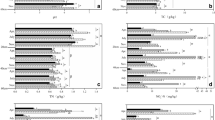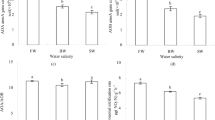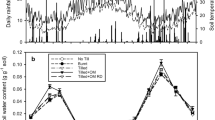Abstract
Ammonia oxidation has been intensively studied for its sensitivity to environmental shifts and stresses. However, acute stress effects on the occurrence and composition of ammonia oxidizing bacteria (AOB) and archaea (AOA) based on expression of related molecular markers in complex soil environments have been to an extent overlooked, particularly concerning transient but commonly occurring environmental changes like soil moisture shifts. The present study investigates the responses of AOB and AOA to moisture shifts and high Zn soil content. AmoA gene copies and transcripts of AOB and AOA along with potential nitrification activity were measured in a soil microcosm approach for investigating the referred environmental shifts. Moisture change from 87 to 50 % of the water holding capacity caused a ~99 % reduction of AOB but not of AOA amoA transcripts that did not change significantly. Increasing applied zinc concentrations resulted in a reduction of potential nitrification rates and negatively affected studied gene expressions of both AOB and AOA, with AOB being more responsive. Both 16 S rRNA and amoA transcripts of AOB had an inverse relation to the applied zinc, indicating a gradual loss in total cell activity. Our results suggest the existence of pronounced differences between AOB and AOA concerning ammonia oxidation activity.




Similar content being viewed by others
References
Smolders E, Brans K, Coppens F, Merckx R (2001) Potential nitrification rate as a tool for screening toxicity in metal-contaminated soils. Environ Toxicol Chem 20:2469–2474
vanBeelen P, Doelman P (1997) Significance and application of microbial toxicity tests in assessing ecotoxicological risks of contaminants in soil and sediment. Chemosphere 34:455–499
Rusk JA, Hamon RE, Stevens DP, McLaughlin MJ (2004) Adaptation of soil biological nitrification to heavy metals. Environ Sci Technol 38:3092–3097
Radniecki TS, Ely RL (2008) Zinc chloride inhibition of Nitrosococcus mobilis. Biotechnol Bioeng 99:1085–1095
Radniecki TS, Semprini L, Dolan ME (2009) Expression of merA, amoA and hao in continuously cultured Nitrosomonas europaea cells exposed to zinc chloride additions. Biotechnol Bioeng 102:546–553
Park S, Ely RL (2008) Genome-wide transcriptional responses of Nitrosomonas europaea to zinc. Arch Microbiol 189:541–548
Park S, Ely RL (2008) Candidate stress genes of Nitrosomonas europaea for monitoring inhibition of nitrification by heavy metals. Appl Environ Microbiol 74:5475–5482
Mertens J, Ruyters S, Springael D, Smolders E (2007) Resistance and resilience of zinc tolerant nitrifying communities is unaffected in long-term zinc contaminated soils. Soil Biol Biochem 39:1828–1831
Mertens J, Springael D, De Troyer I, Cheyns K, Wattiau P, Smolders E (2006) Long-term exposure to elevated zinc concentrations induced structural changes and zinc tolerance of the nitrifying community in soil. Environ Microbiol 8:2170–2178
Prosser JI, Embley TM (2002) Cultivation-based and molecular approaches to characterisation of terrestrial and aquatic nitrifiers. Antonie Van Leeuwenhoek 81:165–179
Kowalchuk GA, Stephen JR (2001) Ammonia-oxidizing bacteria: a model for molecular microbial ecology. Annu Rev Microbiol 55:485–529
Koops HP, Pommerening-Roser A (2001) Distribution and ecophysiology of the nitrifying bacteria emphasizing cultured species. FEMS Microbiol Ecol 37:1–9
Rotthauwe JH, Witzel KP, Liesack W (1997) The ammonia monooxygenase structural gene amoA as a functional marker: molecular fine-scale analysis of natural ammonia-oxidizing populations. Appl Environ Microbiol 63:4704–4712
Kowalchuk GA, Stephen JR, De Boer W, Prosser JI, Embley TM, Woldendorp JW (1997) Analysis of ammonia-oxidizing bacteria of the beta subdivision of the class Proteobacteria in coastal sand dunes by denaturing gradient gel electrophoresis and sequencing of PCR-amplified 16S ribosomal DNA fragments. Appl Environ Microbiol 63:1489–1497
Konneke M, Bernhard AE, de la Torre JR, Walker CB, Waterbury JB, Stahl DA (2005) Isolation of an autotrophic ammonia-oxidizing marine archaeon. Nature 437:543–546
de la Torre JR, Walker CB, Ingalls AE, Konneke M, Stahl DA (2008) Cultivation of a thermophilic ammonia oxidizing archaeon synthesizing crenarchaeol. Environ Microbiol 10:810–818
Hatzenpichler R, Lebedeva EV, Spieck E, Stoecker K, Richter A, Daims H, Wagner M (2008) A moderately thermophilic ammonia-oxidizing crenarchaeote from a hot spring. P Natl Acad Sci USA 105:2134–2139
Leininger S, Urich T, Schloter M, Schwark L, Qi J, Nicol GW, Prosser JI, Schuster SC, Schleper C (2006) Archaea predominate among ammonia-oxidizing prokaryotes in soils. Nature 442:806–809
Venter JC, Remington K, Heidelberg JF, Halpern AL, Rusch D, Eisen JA, Wu DY, Paulsen I, Nelson KE, Nelson W, Fouts DE, Levy S, Knap AH, Lomas MW, Nealson K, White O, Peterson J, Hoffman J, Parsons R, Baden-Tillson H, Pfannkoch C, Rogers YH, Smith HO (2004) Environmental genome shotgun sequencing of the Sargasso Sea. Science 304:66–74
Treusch AH, Leininger S, Kletzin A, Schuster SC, Klenk HP, Schleper C (2005) Novel genes for nitrite reductase and Amo-related proteins indicate a role of uncultivated mesophilic crenarchaeota in nitrogen cycling. Environ Microbiol 7:1985–1995
Nicol GW, Schleper C (2006) Ammonia-oxidising Crenarchaeota: important players in the nitrogen cycle? Trends Microbiol 14:207–212
Francis CA, Beman JM, Kuypers MMM (2007) New processes and players in the nitrogen cycle: the microbial ecology of anaerobic and archaeal ammonia oxidation. ISME J 1:19–27
Erguder TH, Boon N, Wittebolle L, Marzorati M, Verstraete W (2009) Environmental factors shaping the ecological niches of ammonia-oxidizing archaea. FEMS Microbiol Rev 33:855–869
Brochier-Armanet C, Boussau B, Gribaldo S, Forterre P (2008) Mesophilic crenarchaeota: proposal for a third archaeal phylum, the Thaumarchaeota. Nat Rev Micro 6:245–252
Tourna M, Stieglmeier M, Spang A, Könneke M, Schintlmeister A, Urich T, Engel M, Schloter M, Wagner M, Richter A, Schleper C (2011) Nitrososphaera viennensis, an ammonia oxidizing archaeon from soil. Proc Natl Acad Sci 108:8420–8425
Schleper C (2010) Ammonia oxidation: different niches for bacteria and archaea? ISME J 4:1092–1094
Jia Z, Conrad R (2009) Bacteria rather than Archaea dominate microbial ammonia oxidation in an agricultural soil. Environ Microbiol 11:1658–1671
Hallam SJ, Mincer TJ, Schleper C, Preston CM, Roberts K, Richardson PM, DeLong EF (2006) Pathways of carbon assimilation and ammonia oxidation suggested by environmental genomic analyses of marine Crenarchaeota. PLoS Biol 4:e95
Martens-Habbena W, Berube PM, Urakawa H, de la Torre JR, Stahl DA (2009) Ammonia oxidation kinetics determine niche separation of nitrifying Archaea and Bacteria. Nature 461:976–979
Nicol GW, Leininger S, Schleper C, Prosser JI (2008) The influence of soil pH on the diversity, abundance and transcriptional activity of ammonia oxidizing archaea and bacteria. Environ Microbiol 10:2966–2978
Mertens J, Broos K, Wakelin SA, Kowalchuk GA, Springael D, Smolders E (2009) Bacteria, not archaea, restore nitrification in a zinc-contaminated soil. ISME J 3:916–923
Ruyters S, Mertens J, Springael D, Smolders E (2010) Stimulated activity of the soil nitrifying community accelerates community adaptation to Zn stress. Soil Biol Biochem 42:766–772
Puglisi E, Hamon RE, Vasileiadis S, Coppolecchia D, Trevisan M (2012) Adaptation of soil microorganisms to trace element contamination: a review of mechanisms, methodologies and consequences for risk assessment and remediation. Crit Rev Environ Sci Technol. doi:10.1080/10643389.2011.592735
Sparks DL (1996) Methods of soil analysis: chemical methods. SSSA, Madison
Day PR (1965) Particle fractionation and particle-size analysis. In: Black CA (ed) Methods of soil analysis. ASA, Madison, pp 545–567
Coppolecchia D, Puglisi E, Vasileiadis S, Suciu N, Hamon R, Maria Beone G, Trevisan M (2011) Relative sensitivity of different soil biological properties to zinc. Soil Biol Biochem 43:1798–1807
Bettinelli M, Beone GM, Spezia S, Baffi C (2000) Determination of heavy metals in soils and sediments by microwave-assisted digestion and inductively coupled plasma optical emission spectrometry analysis. Anal Chim Acta 424:289–296
Kandeler E (1995) Potential nitrification: methods in soil biology. Springer, Heidelberg, pp 146–149
Tourna M, Freitag TE, Nicol GW, Prosser JI (2008) Growth, activity and temperature responses of ammonia-oxidizing archaea and bacteria in soil microcosms. Environ Microbiol 10:1357–1364
Muyzer G, Dewaal EC, Uitterlinden AG (1993) Profiling of complex microbial-populations by denaturing gradient gel-electrophoresis analysis of polymerase chain reaction-amplified genes-coding for 16 S ribosomal-RNA. Appl Environ Microbiol 59:695–700
Buntjer JB (1999) Cross Checker Fingerprint analysis software v2.9. Wageningen University and Research Centre, Wageningen
Marzorati M, Wittebolle L, Boon N, Daffonchio D, Verstraete W (2008) How to get more out of molecular fingerprints: practical tools for microbial ecology. Environ Microbiol 10:1571–1581
Jongman RHG, ter Braak CJF, van Tongeren OFR (1995) Data analysis in community and landscape ecology. Cambridge University Press, Cambridge
R Development Core Team (2009) R: a language and environment for statistical computing, reference index version 2.2.1. R Foundation for Statistical Computing, Vienna
Kindt R, Coe R (2005) Tree diversity analysis. A manual and software for common statistical methods for ecological and biodiversity studies. World Agroforestry Centre (ICRAF), Nairobi
Stark J, Firestone M (1995) Mechanisms for soil moisture effects on activity of nitrifying bacteria. Appl Environ Microbiol 61:218–221
Martin DD, Ciulla RA, Roberts MF (1999) Osmoadaptation in Archaea. Appl Environ Microbiol 65:1815–1825
Mußmann M, Brito I, Pitcher A, Sinninghe Damsté JS, Hatzenpichler R, Richter A, Nielsen JL, Nielsen PH, Müller A, Daims H, Wagner M, Head IM (2011) Thaumarchaeotes abundant in refinery nitrifying sludges express amoA but are not obligate autotrophic ammonia oxidizers. Proc Natl Acad Sci 108:16771–16776
Pratscher J, Dumont MG, Conrad R (2011) Ammonia oxidation coupled to CO2 fixation by archaea and bacteria in an agricultural soil. Proc Natl Acad Sci 108(10):4170–5
Pester M, Schleper C, Wagner M (2011) The Thaumarchaeota: an emerging view of their phylogeny and ecophysiology. Curr Opin Microbiol 14:300–306
Smith CJ, Osborn AM (2009) Advantages and limitations of quantitative PCR (Q-PCR)-based approaches in microbial ecology. FEMS Microbiol Ecol 67:6–20
Klappenbach JA, Dunbar JM, Schmidt TM (2000) rRNA operon copy number reflects ecological strategies of bacteria. Appl Environ Microbiol 66:1328–1333
Levy-Booth DJ, Campbell RG, Gulden RH, Hart MM, Powell JR, Klironomos JN, Pauls KP, Swanton CJ, Trevors JT, Dunfield KE (2007) Cycling of extracellular DNA in the soil environment. Soil Biol Biochem 39:2977–2991
Offre P, Prosser JI, Nicol GW (2009) Growth of ammonia-oxidizing archaea in soil microcosms is inhibited by acetylene. FEMS Microbiol Ecol 70:99–108
Verhamme DT, Prosser JI, Nicol GW (2011) Ammonia concentration determines differential growth of ammonia-oxidising archaea and bacteria in soil microcosms. ISME J 5:1067–1071
Xia W, Zhang C, Zeng X, Feng Y, Weng J, Lin X, Zhu J, Xiong Z, Xu J, Cai Z, Jia Z (2011) Autotrophic growth of nitrifying community in an agricultural soil. ISME J 5:1226–1236
Schleper C (2010) Ammonia oxidation: different niches for bacteria and archaea? ISME J 4:1092–1094
Acknowledgments
The present study was carried out as part of the GEBEP project funded by the Cariplo Foundation (Italy) and was also supported by the Doctoral School on the Agro-Food System (Agrisystem) of the Università Cattolica del Sacro Cuore (Italy).
Author information
Authors and Affiliations
Corresponding author
Rights and permissions
About this article
Cite this article
Vasileiadis, S., Coppolecchia, D., Puglisi, E. et al. Response of Ammonia Oxidizing Bacteria and Archaea to Acute Zinc Stress and Different Moisture Regimes in Soil. Microb Ecol 64, 1028–1037 (2012). https://doi.org/10.1007/s00248-012-0081-3
Received:
Accepted:
Published:
Issue Date:
DOI: https://doi.org/10.1007/s00248-012-0081-3




